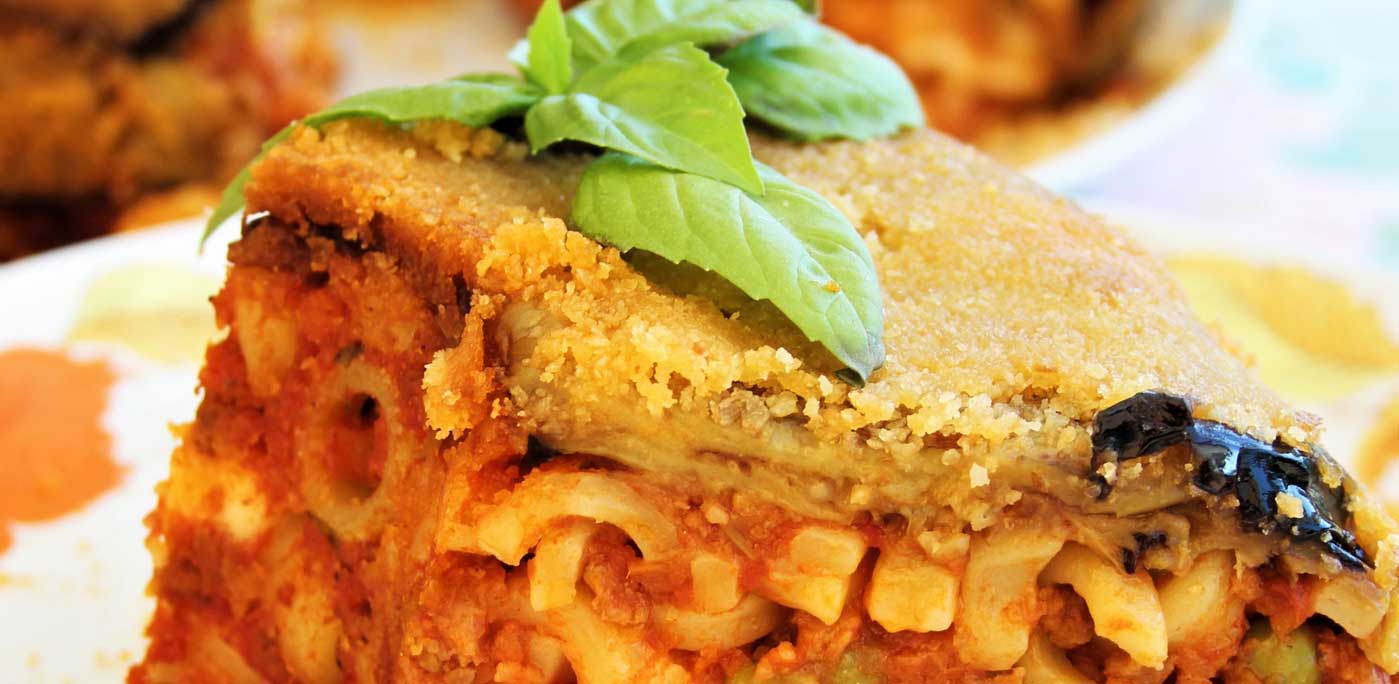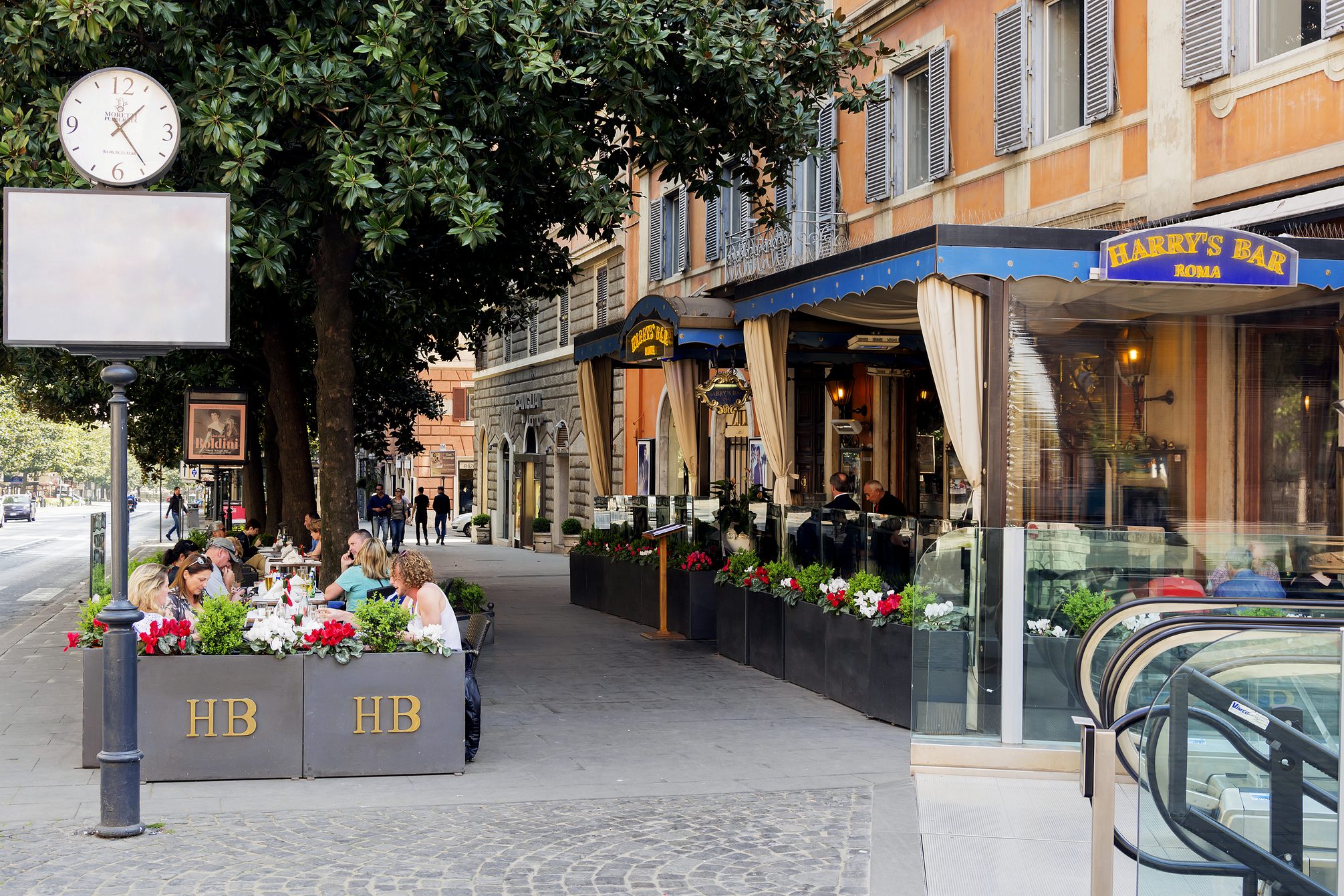Baked anelletti pasta is a recipe traditional to Palermo, but it is a dish that holds a special place in the hearts of almost all Sicilians.
If you visit Palermo and you hear someone say “timballo,” then rest assured: they are most probably talking about baked anelletti alla Palermitana! In Palermo, this recipe has a couple of strict requirements and one is that the only type of pasta allowed is anelletti, little pasta rings. Secondly, the timballo must be round and, when it is turned upside down on a serving plate, the slices of fried eggplant placed on the bottom of the pan must create a decorative casing to the wonderful contents inside.

(Copyrights: Toni Brancatisano)
Having said that, you may find smaller, individual portions of timballo sold as a popular street food. I have made one like this, too, so you can see how these may look like.
This baked pasta recipe is obviously made throughout Sicily with many variations to the ingredients. You will find recipes containing salami, mortadella, prosciutto cotto (ham), eggs, slices of provola or any other cheese that may be in the fridge. I love eggplant, so I like to add extra stirred through the pasta.

(Copyrights: Toni Brancatisano)
Each family will tell you their way of making it, but be aware: each family will also tell you their recipe is the best and the only one to use! I have kept this one pretty simple where ingredients are concerned, but you can get as creative as you like.
This recipe needs time to put it all together, so read the it thoroughly first, so you can make sure you have enough time to prepare it without feeling rushed or under pressure.

(Copyrights: Toni Brancatisano)
Timballo di anelletti al forno alla Palermitana
Ingredients
- 18 oz packet Sicilian anelli pasta
- 9 oz mince pork
- 9 oz mince veal
- 4 large eggplants
- 1 garlic clove
- 1 large carrot
- 1 large red onion
- 2 celery ribs
- 125ml red wine
- 3 cans tomato ‘polpa’ (about 1.5litres)
- 5 oz concentrated tomato paste
- handful of fresh basil
- small bunch parsley, chopped
- 7 oz frozen peas
- 3 1/2 oz cheese cut into cubes (tuma, caciocavallo, pecorino)
- 2 bay leaves
- 1 cup breadcrumbs
- salt and pepper
- Extra Virgin Olive Oil

(Copyrights: Toni Brancatisano)
Method
First, make the ragù.

(Copyrights: Toni Brancatisano)
- Finely chop the onion, carrot, parsley and celery and add everything to a deep heavy based saucepan with about 60 ml olive oil (a generous splash)!
- Add the garlic clove sliced in half and fry everything in the oil until the onion is translucent and slightly browned.
- Add the minced pork and veal, cook on a high heat for 2 minutes and then add the red wine. When the alcohol has evaporated and the mixture appears “dry,” remove the garlic.
- Add the tomato paste and stir well. Next, add the tomato “polpa” and the peas. Stir well.
- Add the basil and the bay leaves, the salt and pepper.
- Cook for 90 minutes on medium heat, stirring frequently to avoid the ragù sticks to the saucepan.
- Take 3 of the eggplants and wash them. Cut off the stalk on top and then slice vertically, trying to keep each slice the same width. (about 4mm). Layer the slices in a colander and sprinkle rock salt on each layer. Let sit for an hour to release bitter juices from the eggplant.
- Wash and slice the remaining eggplant into cubes, and add to the colander with salt. After an hour, rinse the eggplant under running water and pat dry on a clean, dry tea towel.
- Add olive oil to the bottom of a large frying pan, and fry all the eggplant slices in batches on each side until golden and cooked. Do the same with the eggplant cubes. Drain on absorbent kitchen paper.
- Boil water in a large saucepan, add salt and then add the pasta. Drain after half the cooking time, and return to the saucepan.
- Put 2 cups of the ragù aside and then add enough ragù to cover all the pasta well. Stir through the fried eggplant cubes.
- Brush the inside of the round baking pan with olive oil. Add the breadcrumbs and shake the pan to cover the whole internal part with the breadcrumbs. Tip out the excess.
- Line the pan with the fried eggplant slices. Fill half the pan with the pasta. Add the ragù set aside, and the cheese then fill the pan with the remaining pasta. Press down to make it all level.
- Sprinkle the top with breadcrumbs and some olive oil and then bake in the oven for 30 minutes at 200°C.
- Allow to rest for a couple of minutes. Place a large serving plate on top of the pan, and quickly flip it over. Buon Appetito!
Anelletti al forno alla palermitana è una ricetta tradizionale di Palermo ma è un piatto che occupa un posto speciale nel cuore di quasi tutti i siciliani. Se visitate Palermo e sentite qualcuno dire “Timballo”, allora sappiate che probabilmente stanno parlando di Anelletti al forno alla palermitana!
A Palermo, questa ricetta ha un paio di rigidi requisiti e uno è che l’unico tipo di pasta consentito sono gli anelletti. L’altro è la forma del Timballo. Deve essere rotondo e quando viene capovolto su un piatto da portata, le fette di melanzane fritte che sono state posizionate sul fondo della padella creano un involucro decorativo per i meravigliosi contenuti che sono all’interno. Detto questo, potreste trovare versioni più piccole che sono singole porzioni vendute come cibo di strada. Ne ho creato uno anche così, così potete vedere come può apparire.
Questa ricetta di pasta al forno è ovviamente realizzata in tutta la Sicilia con molte varianti relativamente agli ingredienti. Troverete ricette che contengono salame, mortadella, prosciutto cotto, uova o fette di provola o qualsiasi altro formaggio che potrebbe essere in frigo. Adoro le melanzane, quindi mi piace aggiungere cubetti fritti mescolati alla pasta.
Ogni famiglia vi dirà il suo modo di farlo, ma per favore sappiate anche… che ogni famiglia vi dirà che la sua ricetta è la migliore e l’unica ricetta da seguire. Qui ho usato ingredienti piuttosto semplici ma potete essere creativi quanto volete.
Questa ricetta ha bisogno di tempo per essere realizzata, quindi leggetela attentamente in modo che da assicurarsi di avere abbastanza tempo per metterla insieme senza sentirsi affrettati o sotto pressione.
INGREDIENTI
- 500g anelletti siciliani
- 250g di macinato di carne di maiale
- 250g di macinato di carne di vitello
- 4 melanzane grandi
- 1 spicchio d’aglio
- 1 carota grande
- 1 grande cipolla rossa
- 2 costole di sedano
- 125 ml di vino rosso
- 1.5 litri (circa 1300g) di polpa di pomodoro
- 150g di concentrato di pomodoro
- 1 manciata di basilico fresco
- 1 mazzetto di prezzemolo tritato
- 200g di piselli
- 100g di formaggio tagliato a cubetti (toma, caciocavallo, pecorino)
- 2 foglie di alloro
- pangrattato quanto basta
- sale e pepe q.b.
- Olio extravergine d’oliva
Istruzioni
- Per preparare il ragù, cominciare tritando finemente al coltello il sedano, la carota, il prezzemolo e la cipolla. Versare l’olio d’oliva in una casseruola e aggiungere il trito e l’aglio tagliato a metà. Lasciarlo cuocere per una decina di minuti a fuoco dolce e mescolare di tanto in tanto. Trascorso il tempo, il soffritto dovrà risultare appassito e la cipolla leggermente dorata.
- Aggiungere la carne di manzo e di maiale macinata. Farla rosolare lentamente per una decina di minuti, mescolando ogni tanto, finchè i succhi non saranno fuoriusciti e il tutto diventato asciutto.
- Aggiungere il vino rosso e fare sfumare. Non appena l’alcol sarà evaporato e il fondo sarà tornato, ancora una volta, ben asciutto, togliere l’aglio e aggiungere il concentrato di pomodoro. Mescolare bene e poi aggiungere la polpa di pomodoro e i piselli.
- Aggiungere il basilico e le foglie di alloro. Aggiungere sale e pepe.
- Cuocere per 90 minuti a fuoco medio, mescolando spesso per evitare che il ragù non si attacchi alla base della casseruola.
- Prendere 3 melanzane e lavarle. Tagliare il gambo in alto e poi tagliarle in verticale, cercando di mantenere ogni fetta della stessa larghezza. (circa 4mm). Mettere le fette in uno scolapasta e cospargerle di sale grosso su ogni strato. Lasciarle riposare per un’ora per far uscire i succhi amari dalle melanzane.
- Lavare e tagliare a cubetti la rimanente melanzana e aggiungere al colino con sale. Dopo un’ora, sciacquare le melanzane sotto l’acqua corrente e asciugarle con un canovaccio pulito e asciutto.
- Aggiungere abbondante l’olio d’oliva sul fondo di una padella larga e friggere tutte le fette di melanzane in lotti, su ciascun lato, fino a dorarle. Fare lo stesso con i cubetti di melanzane. Scolare tutto su carta assorbente da cucina.
- Far bollire l’acqua, aggiungere il sale e quindi aggiungere la pasta. Scolare dopo metà del tempo di cottura e rimetterla nel tegame. Mettere da parte 2 tazze di ragù e poi aggiungere abbastanza ragù per coprire bene tutta la pasta. Mescolarci dentro anche la melanzana fritta a cubetti.
- Ungere con dell’olio d’oliva una teglia e poi coprire l’intera parte interna con il pangrattato. Agitare la teglia per ottenere una buona copertura di pangrattato e fare fuoriuscire l’eccesso.
- Foderare la teglia con le fette di melanzane fritte. Riempire metà della teglia con la pasta. Aggiungere il ragù messo da parte e il formaggio quindi riempire la padella con la pasta rimanente. Premere leggermente per livellare il tutto.
- Cospargere la parte superiore con pangrattato e un po’ di olio d’oliva, quindi cuocere in forno per 30 minuti a 200°C.
- Lasciare riposare il timballo per un paio di minuti. Posizionare un piatto da portata grande sulla parte superiore della padella e capovolgerlo rapidamente. Buon Appetito!




































